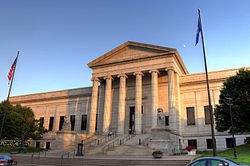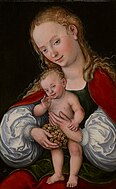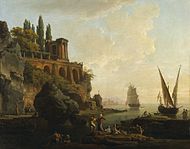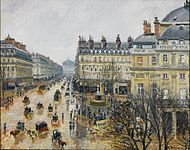Minneapolis Institute of Art
 | |
 | |
| Established | 1883 |
|---|---|
| Location | 2400 Third Avenue South Minneapolis, Minnesota |
| Coordinates | 44°57′31″N 93°16′27″W / 44.95861°N 93.27417°W |
| Director | Kaywin Feldman |
| Website | artsmia.org |
The Minneapolis Institute of Art (Mia), formerly known as the Minneapolis Institute of Arts,[1][2] is a fine art museum located in the Whittier neighborhood of Minneapolis, Minnesota, on a campus that covers nearly 8 acres (32,000 m²), formerly Morrison Park. As a major, government-funded public museum, the Institute does not charge an entrance fee, except for special exhibitions, and allows photography of its permanent collection for personal or scholarly use only. The museum receives support from the Park Board Museum Fund, levied by the Hennepin County commissioners. Additional funding is provided by corporate sponsors and museum members.[3] It is one of the largest art museums in the United States.
History

The Minneapolis Society of Fine Arts began in 1883 to bring the arts into the life of the community. This group, made up of business and professional leaders of the time, organized art exhibits throughout the decade. In 1889, the Society, now known as the Minneapolis Institute of Art, moved into its first permanent space inside the newly built Minneapolis Public Library.
The institute received gifts from Clinton Morrison and William Hood Dunwoody among others for their building fund. In 1911, Morrison donated the land, formerly occupied by his family's Villa Rosa mansion, in memory of his father Dorilus Morrison, contingent on the institute raising the $500,000 needed for the building. A few days later they received a letter from Dunwoody who got the ball rolling, "Put me down for $100,000." Well on their way, a fundraising dinner a few days later raised $335,500 more, donated in 90 minutes.[5]
A new museum building, designed by the firm of McKim, Mead and White, opened its doors in 1915. The museum came to be recognized as one of the finest examples of the Beaux-Arts architectural style in Minnesota. Art historian Bevis Hillier organized an exhibition called Art Deco at Mia that took place from July to September 1971, which caused a great resurgence of interest in this style of art. The building was originally meant to be the first of several sections but only this front piece was ultimately built; several additions have subsequently been built according to other plans, including a 1974 addition by Kenzo Tange. An expansion designed by Michael Graves was completed in June 2006. Before the latest expansion, just 4 percent of the museum's nearly 100,000 objects could be on view at the same time; now that figure is 5 percent.[6] Target Corporation, for which the new wing is named, was the biggest donor, with a lead gift of more than $10 million.[6]
In 2015 the museum rebranded itself, abandoning the final "s" in its name to become the Minneapolis Institute of Art, and encouraging the use of the nickname "Mia" instead of its acronym MIA.[1][2]
Collections



Mia features an encyclopedic collection of approximately 80,000 objects[7] spanning 5,000 years of world history. Its collection includes paintings, photographs, prints & drawings, textiles, architecture, and decorative arts. There are collections of African art and art from Oceania and the Americas, and an especially strong collection of Asian art, called "one of the finest and most comprehensive Asian art collections in the country".[8] The Asian collection includes Chinese architecture, jades,[9] bronzes, and ceramics.[8]
The institute owns the Purcell-Cutts House just east of Lake of the Isles. The house was designed by Purcell & Elmslie and is a masterpiece of Prairie School architecture. It was donated to the museum by Anson B. Cutts Jr., the son of its second owner. The house is available for tours on the second weekend of each month.[10][11]
Services
In order to encourage private collecting and assist in the acquisition of important works of art, the museum has created "Affinity Groups" aligned with the seven curatorial areas of the museum. The groups schedule lectures, symposia, and travel for members.
The museum features a regular series of exhibitions that bring in traveling collections from other museums for display. Local business partners fund many of these exhibitions and some feature the artists themselves leading public tours through the exhibition.
The museum houses the Minnesota Artists Exhibition Program (MAEP), an artist-controlled program devoted to the exhibition of works by artists who live in Minnesota.[12]
Funding
The William Hood Dunwoody Fund was endowed with one million dollars when Dunwoody died in 1914, and has been used to purchase thousands of works.[13] Bruce Dayton, a life trustee of the Minneapolis Institute of Art since 1942, insisted that money raised in the $100 million fund-raising campaign for the Target wing, which opened in 2006, be split 50-50 between the building and the acquisitions endowment. That fund, now at $91 million, has allowed the institute to buy a rare early 18th-century Native American painted buckskin shirt and a nine-foot-long topographical View of Venice made by Jacopo de' Barbari in 1500, among other recent purchases.[14] In 2009, the value of the museum's $145 million endowment dropped 21 percent from January 2008. The endowment typically provides nearly one-fifth of operating revenues. Contributions from individuals, corporations and foundations account for a quarter of revenues,[15] Almost half of the museum's operating money comes from the "park-museum fund," a century-old Hennepin County tax dating to 1911 that provides public support in exchange for free admission. That fund, which has risen steadily in recent years, provided the museum $12.6 million in the fiscal year of 2010. In 2011, the museum's annual budget was at $24.6 million, and endowment income was a total $4.3 million.[16]
Works of art
-
Lucas Cranach the Elder, Portrait of Moritz Buchner, 1518
-
Lucas Cranach the Elder, Anna Buchner, c. 1520
-
Master of the Embroidered Foliage, Virgin and Child in a Landscape, 1492–1498
-
Lucas Cranach the Elder, Madonna and Child with Grapes, c. 1537
-
Marie Louise Elisabeth, Vigée-Le Brun, Portrait de la comtesse Maria Theresia Bucquoi
-
Alexander Roslin, The Comtesse d'Egmont Pignatelli in Spanish Costume, 1763
-
Sir Joshua Reynolds, Mrs. Froude, née Phyllis Hurrell playing an english guitar.
-
Sir Joshua Reynolds, The Countess of Strafford, 1745
-
Luis de Morales, Man of Sorrows, c. 1560
-
Bartolomé Esteban Murillo, the Penitent Magdalene, c. 1665
-
Gerard van Honthorst, The Denial of St Peter, 1622
-
El Greco, Cleansing of the Temple, 1571
-
Jacob Willemsz Delff, Allegory of the Four Elements, c. 1600
-
Jean Siméon Chardin, The Attributes of Art, 1766
-
François Clouet, The Bath of Diana, 1550s
-
Hendrick ter Brugghen, Card players, 1623
-
Frederic Leighton, Jonathan token to David, c.1868
-
Édouard Manet, The Smoker 1866
-
Robert Koehler, Portrait of Alvina Roosen 1900
-
Claude Joseph Vernet Imaginary Landscape, Italian Harbor Scene, 1746
-
Vincent van Gogh, Olive Trees Saint-Rémy, November 1889
-
Paul Signac, Bénédiction des thoniers à Groix, 1923
-
Camille Pissarro, Place du Théâtre Français, Paris, Rain, 1898
-
Paul Gauguin, Under the Pandanus II, 1891
Trivia
Near the Minneapolis Institute of Art there is a copy of The Fighter of the Spirit statue of Ernst Barlach also called The Ghost Fighter.[17]
See also
Notes
- ^ a b http://www.mprnews.org/story/2015/08/10/feldman-art-museum
- ^ a b http://new.artsmia.org/stories/once-at-mia-whats-in-a-name-2/
- ^ "Minneapolis Institute of Arts".
- ^ "Rembrandt's Lucretias". National Gallery of Art via Internet Archive. Archived from the original on November 17, 2004. Retrieved 2007-01-15.
{{cite web}}: Cite has empty unknown parameter:|1=(help); Unknown parameter|deadurl=ignored (|url-status=suggested) (help) - ^ Gihring, Tim (January 1, 2015). "Mia Stories". Minneapolis Institute of Art. Retrieved August 18, 2015.
- ^ a b Kristin Tillotson (June 9, 2006), Minneapolis Institute of Arts opens new wing Star Tribune.
- ^ "WILLIAM M. GRISWOLD APPOINTED NEW DIRECTOR OF THE MINNEAPOLIS INSTITUTE OF ARTS". Retrieved 2007-07-24.
- ^ a b "New and Improved: The Minneapolis Institute of Arts Reopens". Antiques and the Arts Online. Retrieved 2007-09-04.
- ^ Among these is a 1784 piece believed to be the largest historic jade sculpture outside of China. "Jade Mountain Illustrating the Gathering of Poets at the Lan T'ing Pavilion". Art de l'Asie. www.framemuseums.org. Retrieved 2007-09-04.
- ^ "Purcell-Cutts House". Retrieved 2011-12-02.
- ^ "Unified Vision: The Architecture and Design of the Prairie School". Retrieved 2011-12-02.
- ^ "The Minnesota Artists Exhibition Program (MAEP)". Minneapolis Institute of Arts. Retrieved 2007-09-04.
- ^ "This fund can only be used for the purchase of works of art." in Handbook of the Minneapolis institute of arts. Minneapolis Institute of Art via Google Books. 1922. p. viii. Retrieved August 16, 2015.
- ^ Judith H. Dobrzynski (March 14, 2012), How an Acquisition Fund Burnishes Reputations New York Times.
- ^ Mary Abbe (March 5, 2009), Hard times reach arts world: MIA cuts staff Star Tribune.
- ^ Mary Abbe (April 20, 2011), Minneapolis Institute of Arts cuts jobs to salvage budget Star Tribune.
- ^ Photo of the copy in Minneapolis
External links
- Arts organizations in Minneapolis, Minnesota
- Culture of Minneapolis, Minnesota
- Museums in Minneapolis, Minnesota
- McKim, Mead, and White buildings
- Michael Graves buildings
- Art museums in Minnesota
- Beaux-Arts architecture in Minnesota
- FRAME Museums
- Art museums established in 1883
- 1883 establishments in Minnesota
- Asian art museums in the United States
























